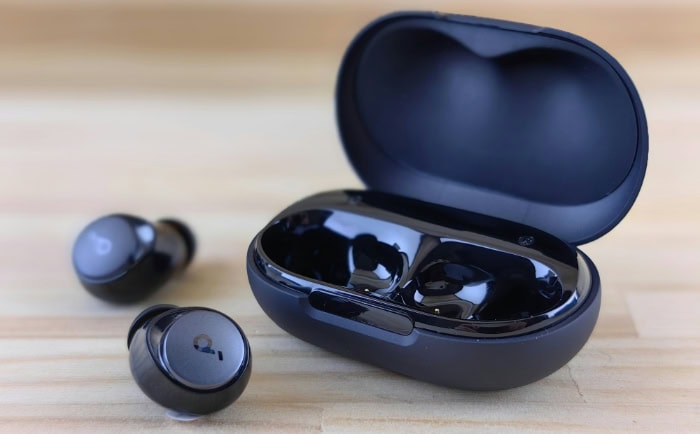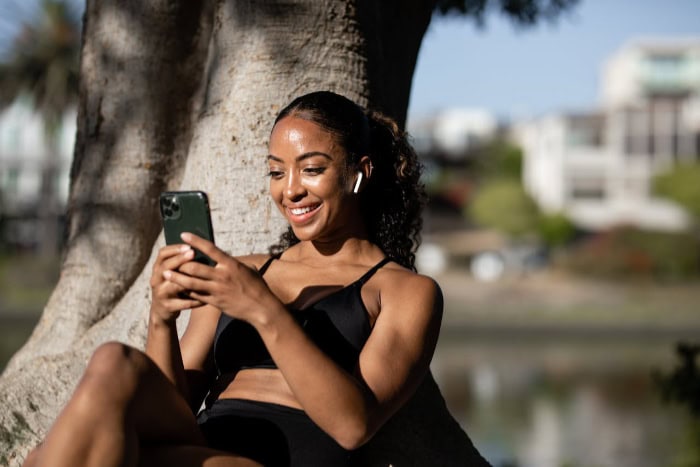What Are True Wireless (TWS) Earbuds? Explained

True wireless earbuds promise a world without tangled cords, packing stereo sound into two tiny, independent earpieces. This complete wireless freedom has made them a popular choice for everything from commuting to workouts.
But with this convenience comes a new set of considerations; how do they maintain a stable connection, and what makes one pair sound better than another?
What Are True Wireless (TWS) Earbuds?
True wireless earbuds represent a significant shift in personal audio, offering a completely untethered listening experience. Unlike conventional wireless earphones that are connected by a neckband or cable, true wireless models consist of two entirely separate earpieces.
This design provides unparalleled freedom of movement, but it also relies on sophisticated internal components to deliver synchronized, high-quality stereo sound.
The Core Design
At their most basic, true wireless earbuds are two independent audio devices that work in tandem. Each earbud functions as a self-contained unit, housing its own battery, processor, and Bluetooth receiver.
They receive distinct left and right audio channels from a source device, such as a smartphone or laptop, creating a genuine stereo soundscape without a physical link between them. This complete separation is what defines them as “true wireless” and is their main advantage over other Bluetooth headphones.
Connection and Communication
TWS earbuds use Bluetooth to establish a connection with an audio source and with each other. In many designs, one earbud acts as the primary receiver, connecting to the phone and then relaying the audio signal to the second earbud.
More advanced systems allow each earbud to connect to the source device simultaneously, which can improve connection stability and reduce latency. Specific Bluetooth profiles manage the audio stream, enabling both stereo music playback and monaural audio for voice calls.
The Role of the Charging Case
The charging case is a fundamental component of the TWS ecosystem, serving multiple purposes beyond simple storage. Its primary function is to recharge the earbuds, as each earpiece contains a very small battery.
The case itself holds a larger battery, allowing for multiple recharges on the go. Furthermore, the case facilitates seamless operation; opening the lid or removing the earbuds typically powers them on and initiates the pairing process with a known device automatically.
Placing them back in the case powers them off and begins charging, streamlining their daily use.
How TWS Earbuds Work

The wire-free convenience of true wireless earbuds is made possible by sophisticated miniature engineering. Each earbud operates as a tiny, self-sufficient device, with numerous components working together to manage the connection, process audio, and respond to user commands.
Their seamless performance depends on the precise coordination of this internal hardware and software.
Wireless Architecture
Every TWS earbud is a complex electronic system packed into a very small form factor. Inside each housing is a Bluetooth chipset that handles all wireless communication, paired with a compact antenna for sending and receiving signals.
A dynamic driver converts the digital audio signal into audible sound, while one or more microphones are included for voice calls and features like active noise cancellation. A small, rechargeable battery powers all of these components.
The efficient operation of these parts in unison is what enables a stable and high-quality audio experience.
Pairing and Stereo Audio
To function, TWS earbuds must first be paired with a source device, such as a smartphone, through its Bluetooth settings. Following this one-time setup, the earbuds will automatically reconnect to that device whenever they are taken out of their charging case.
For stereo sound, the audio stream is split into separate left and right channels. This information is then delivered to the correct earbud, creating synchronized playback for a proper stereo image.
This process ensures that music and other media are heard as intended.
Controls and Smart Sensors
Interaction with TWS earbuds is designed to be simple and intuitive. Most models feature touch-sensitive surfaces or small physical buttons that allow for controlling media playback, adjusting volume, or answering calls without needing to reach for the source device.
To make the experience even more fluid, many earbuds incorporate proximity sensors that can detect when they are placed in or removed from the ear, automatically pausing and resuming audio accordingly. These user-focused features, combined with the case-activated power and pairing functions, help simplify their integration into daily routines.
Core Features and Specifications
While most true wireless earbuds appear similar on the surface, their performance is defined by a specific set of technical details. These specifications directly influence everything from sound quality and connection strength to battery endurance and daily convenience.
Sound Fidelity and Codecs
The audio quality of TWS earbuds is determined by both their physical hardware and the software they use to process sound. Each earbud contains a driver, which is the small speaker component responsible for producing sound.
Beyond the driver, audio fidelity is heavily influenced by Bluetooth codecs. Codecs are algorithms that compress and decompress digital audio for wireless transmission.
Common codecs like AAC and aptX can handle more data than the standard SBC codec, resulting in better sound quality and lower latency, which is important for keeping audio in sync with video. For the best results, both the earbuds and the source device must support the same advanced codec.
Connectivity and Controls
A stable wireless connection is crucial for a positive TWS experience. The Bluetooth version used by the earbuds affects connection reliability, range, and power efficiency.
More recent versions generally offer improved performance. Some earbuds also feature multipoint support, which allows them to maintain a connection to two devices simultaneously, such as a laptop and a phone, making it easy to switch between them.
Controls are typically managed through touch-sensitive surfaces or physical buttons on the earbuds, providing a way to play or pause music, skip tracks, and answer calls without interacting with the source device.
Battery Life and Charging
Power management is a central aspect of true wireless earbuds. Performance is measured by two separate figures: the playback time available from the earbuds on a single charge and the additional power provided by the charging case.
Manufacturers usually state both the earbud battery life and the total listening time achievable with case recharges. Many models also offer a quick-charge function, which can provide an hour or more of playback from just a few minutes of charging.
The total time required to fully charge both the earbuds and the case is another important consideration for daily use.
Benefits and Common Uses

The defining characteristic of true wireless earbuds is their complete lack of cables, a design choice that opens up a wide range of applications in daily life. Their small size and self-contained nature make them exceptionally versatile, fitting seamlessly into routines that involve commuting, working, and exercise.
This adaptability is one of the primary reasons for their widespread adoption.
Portability and Unrestricted Movement
True wireless earbuds offer an unmatched level of portability and freedom. The compact charging case is small enough to fit into a pocket or a small bag, making it easy to carry them everywhere.
Without any wires connecting the earpieces to each other or to a phone, the risk of snagging or tangling is eliminated. This provides a significant advantage during activities like commuting on crowded public transport, performing tasks around the house, or simply moving around an office, as there are no cords to get in the way.
Designs for Active Lifestyles
Many TWS earbuds are built specifically for people with active lifestyles. To ensure they stay in place during vigorous movement, these models often come with various sizes of ear tips and sometimes include small wings or fins for a more secure fit.
Another important attribute is their resistance to moisture. Manufacturers often provide an IP (Ingress Protection) rating, which indicates the level of protection against water and sweat.
A sufficient rating makes these earbuds a reliable choice for workouts at the gym or for running outdoors, even in light rain.
Flexible and Situational Listening
TWS earbuds provide several flexible listening options to suit different environments and needs. It is possible to use just a single earbud for mono audio, which is useful for taking phone calls or listening to a podcast while maintaining awareness of your surroundings.
Using one earbud at a time can also extend the total listening period, as one can be charged while the other is in use. Additionally, many models include a transparency or ambient sound mode.
This feature uses the built-in microphones to channel external sounds into your ears, allowing you to hear conversations or public announcements without having to remove the earbuds.
Challenges and Practical Solutions
Despite their convenience, true wireless earbuds can present some common frustrations. From connection glitches to finding a comfortable fit, users may encounter issues that can disrupt the listening experience.
Fortunately, most of these problems have straightforward solutions that can restore functionality and improve overall satisfaction.
Connection Stability
Wireless connections can sometimes be unreliable, leading to audio dropouts or pairing failures. When these issues occur, the first step is to consult the manufacturer's instructions to ensure the correct pairing procedure was followed.
If problems persist, performing a full reset of the earbuds can often clear up software glitches. It is also helpful to manage the physical environment, as Bluetooth signals are susceptible to interference from other wireless devices and can be blocked by physical obstacles.
Keeping the audio source device close, for instance, in a front pocket instead of a back pocket, can often stabilize the connection and prevent interruptions.
Achieving a Comfortable and Secure Fit
A proper fit is essential not only for comfort but also for audio quality and noise isolation. A poor seal between the ear tip and the ear canal will result in weak bass and allow ambient noise to leak in, diminishing the listening experience.
Most TWS earbuds include several pairs of ear tips in different sizes and sometimes different shapes. Taking the time to experiment with these options is crucial for finding a combination that creates a secure seal without causing pressure or discomfort.
A good fit ensures the earbuds stay in place during movement and deliver their best possible sound.
Maintaining Battery Health
The small batteries inside TWS earbuds require some care to preserve their capacity over time. The most effective habit is to store the earbuds in their charging case whenever they are not in use.
This practice protects them and keeps their batteries topped up for the next session. It is also important to avoid exposing the earbuds and their case to extreme temperatures, as excessive heat or cold can permanently damage the batteries.
While the quick-charge feature is convenient, using it sparingly in favor of standard charging cycles can help reduce stress on the battery and support its long-term performance.
How to Choose the Right TWS Earbuds

Selecting the best true wireless earbuds is a personal decision that depends heavily on individual needs and listening habits. With countless models available, focusing on a few core areas can help narrow down the options.
Connection and Audio Codecs
The foundation of a good pair of TWS earbuds is a reliable Bluetooth connection. Look for models with a modern Bluetooth implementation, as this generally contributes to a more stable signal with fewer dropouts and better power efficiency.
Beyond stability, the supported audio codecs directly impact sound quality. For instance, iPhone users should look for AAC support, while many Android devices benefit from aptX.
Ensuring the earbuds support the best codec your phone can offer is important for achieving higher-fidelity audio and minimizing latency, which prevents a noticeable delay between video and sound.
Matching Features to Your Needs
The right features depend entirely on how and where you plan to use your earbuds. If you frequently travel or work in noisy places, active noise cancellation (ANC) can be a significant benefit for blocking out distractions.
Conversely, a transparency mode is useful for maintaining situational awareness. For those who make frequent calls, microphone quality should be a top priority.
Other software enhancements, such as a companion app with a customizable equalizer (EQ), allow you to tailor the sound profile to your preferences. The type of on-bud controls, whether touch-based or physical buttons, is also a matter of personal preference.
Comfort, Battery, and Overall Value
Long-term satisfaction often comes down to comfort and practicality. Since every ear is different, a secure and comfortable fit is essential.
It is best to choose earbuds that come with multiple ear tip options, and if possible, try them on to assess their weight and how they feel over time. Battery life is another critical factor; consider the total playback time available when including recharges from the case, not just the earbuds' single-charge duration.
Finally, consider the overall value by balancing the price with the brand's reputation, warranty support, and the specific features that meet your requirements.
Conclusion
Choosing the right true wireless earbuds comes down to a focused evaluation of a few core elements that directly impact your daily experience. A stable connection and compatibility with your devices provide the foundation for frustration-free listening, while a comfortable and secure fit is what makes them wearable for hours at a time.
Once those basics are met, the decision rests on matching specific functions, such as active noise cancellation or microphone quality, to your personal routine. By concentrating on reliable connectivity, physical comfort, battery performance, and the features you will actually use, you can select a pair of earbuds that seamlessly integrates into your life without unnecessary trade-offs or complexity.


